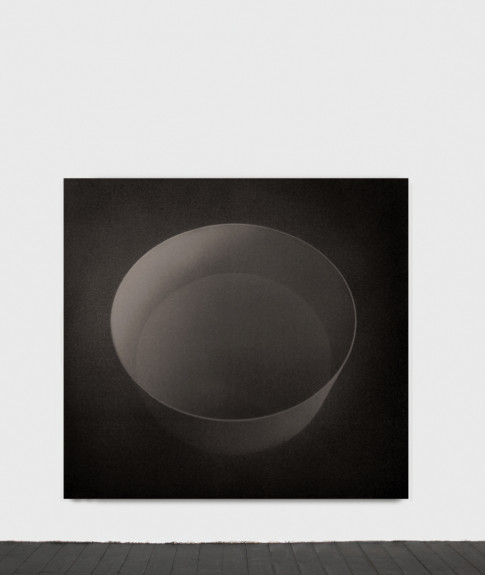
Marco Tirelli
“It is not in the form of the spoils that fall to the victor that [refined and spiritual things] make their presence felt in the class struggle.They manifest themselves in this struggle [of the oppressed] as courage, humour and fortitude.They have retroactive force and will constantly call into question every victory past and present of the rulers. As flowers turn toward the sun, by dint of a secret heliotropism the past strives to turn toward the sun which is rising in the sky of history.”
Walter Benjamin
Letter to Gershom Scholem
“Architecture is cultic, it is mark, symbol, sign, expression.”
Hans Hollein
“Art is reparative, its intention is to restore psychic health, and its proposal — anticipation — of autonomy, is not an idealistic, self defeating illusion, but a means of articulating just what health means.”
Donald Kuspit
“The Germans are beating us at our own game.”
Joseph De Jarnett, Superintendent, Western State Hospital, Virginia. 1934 (Richmond Times).
It seems that children are the latest target of the new authoritarian states. The blatant naked war crimes in Gaza are disproportionately against children. In the U.S. the Obama administration is making plans to repatriate the refugee children who have crossed the border and are now sleeping on cement floors in make shift immigrant shelters in Texas and Arizona. What is the message here? In Gaza schools are bombed, and hospitals and journalists killed and harassed. The message of the Israeli state has always been controlled by Israel. That control is eroding.
“De-Arabizing the history of Palestine is another crucial element of the ethnic cleansing. 1500 years of Arab and Muslim rule and culture in Palestine are trivialized, evidence of its existence is being destroyed and all this is done to make the absurd connection between the ancient Hebrew civilization and today’s Israel. The most glaring example of this today is in Silwan, (Wadi Hilwe) a town adjacent to the Old City of Jerusalem with some 50,000 residents. Israel is expelling families from Silwan and destroying their homes because it claims that King David built a city there some 3,000 years ago.”
Miko Peled

Palestinian refugee camp, 1948.
In Iraq the U.S. encouraged the looting of museums and the offices of culture. The history and identity of Muslim culture is being wiped out across the middle east. The next generation in Gaza is being wiped out. There are precious few social services for the young in the United States. The cultural memory of black and latino communities is being erased through heightened policing, and the threat of arrest and prison. Israel holds almost 25% of the adult male population of Gaza and The West Bank in prison. Hundreds of Palestinian children are held in Israeli prisons, too.
“In 1958, a decade after the Nakba, the Israeli authorities destroyed 27,000 books, most of them Palestinian textbooks from the pre-1948 period, claiming that they were either useless or threatened the state. The authorities sold the books to a paper plant.”
Evan Jones

Eberhard Havekost
The message in mainstream media in the U.S. (interestingly, far less so in Europe) is one that works to de-contextualize the ethnic cleansing, and to constantly beat on the single theme of Hamas and rockets and “terrorist”. It is much more useful to imagine Gaza as a group of nasty keffiyeh wearing Osama bin Ladin types launching *Soviet* missles (both more evil and less effective missiles) at the democratically modern white people of Israel. Gaza is dark, Gaza is Detroit and Watts and Bedford Stuyvestant. Gaza is the Mexico/Arizona border and East L.A., and Stockton CA. The same theme migrates to the U.S. media when they describe black on black crime. The landscapes of the United States increasingly, in places, resembles Gaza and the barren highways between Israeli settlements and Palestinian lands. A scorched earth zone, militarized, stark and stripped of life. The drive between housing tracts in Southern California or Arizona looks much the same.
As William James Martin wrote, and it is exactly what is scrupulously absent in mainstream TV or print media:
“What would you do if you were Hamas, and your offices were being ransacked and destroyed, and your people killed.? And what would you do if the population of Gaza were living under a brutal siege, unable to export their agriculture or the products so their labors, with foodstuffs embargoed allowing only a bare subsistence, with electricity and fuel limited, and potable water in short supply, and with building and rebuilding of destroyed structure from two previous wars with Israel, as well as this one when it ends, impossible because of the Israeli siege?”
But here is the point at which it is important to introduce the idea of race. For race is, essentially, only an idea. An idea applied to biology to shape a value system, a biological ideology in a sense. For Israel, the narrative was the Jew returning home to the land of King David. Never mind thats a fictional King, but its the story that counts, right? Zionism is, itself, not inherently a Jewish project. There was a long tradition of Christian Zionists (and that seems to be regrouping in fact), and it was only in the late 19th century that Theordor Herzl and a small group theorized a colonial project in Palestine. Early Zionist writer Viktor Jabotinsky wrote:
“[It is the] iron law of every colonizing movement, a law which knows of no exceptions, a law which existed in all times and under all circumstances. If you wish to colonize a land in which people are already living, you must provide a garrison on your behalf. Or else–or else, give up your colonization, for without an armed force which will render physically impossible any attempts to destroy or prevent this colonization, colonization is impossible, not “difficult,” not “dangerous” but impossible!… Zionism is a colonizing adventure and therefore it stands or falls by the question of armed force.”
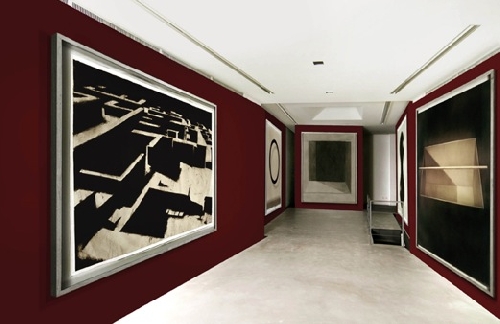
Marco Tirelli. La Galleria Civica di Modena.
The truth is, the entire narrative of ‘return’ for Jews was just a story, a useful one, but certainly one with little historical basis. The Nazi death camps, the European fascism of WW2, provided the narrative engine and a kind of material reference for the return. That said, the return to the land of King David (sic) is still interlaced with the idea of race. The state of Israel is racially defined — and religiously and to a far less extent is it culturally linked to Hebraic culture and learning, for it is in many other ways antithetical to Jewish thought and culture. Much like the U.S. though, a mythology had to be manufactured. The symbols of ancient Herbrew religion, the menorah, the star of David, etc were employed to re-affirm the validity of this Arab land belonging somehow, by God’s decree almost, to the Jews and Zionists. And the shadow cast across all this is race.
Eugenics arose in the mid 1800s. The idea appealed, in different stages, to the far right, the left-ish, the liberals and eventually back to the far right and Hitler. The modern incarnation though could be argued to have arisen in California in the 1920s. The Rockefeller family loved the idea. They funded it.
Edwin Black wrote; “California was considered an epicenter of the American eugenics movement. During the Twentieth Century’s first decades, California’s eugenicists included potent but little known race scientists, such as Army venereal disease specialist Dr. Paul Popenoe, citrus magnate and Polytechnic benefactor Paul Gosney, Sacramento banker Charles M. Goethe, as well as members of the California State Board of Charities and Corrections and the University of California Board of Regents.
Eugenics would have been so much bizarre parlor talk had it not been for extensive financing by corporate philanthropies, specifically the Carnegie Institution, the Rockefeller Foundation and the Harriman railroad fortune. They were all in league with some of America’s most respected scientists hailing from such prestigious universities as Stanford, Yale, Harvard, and Princeton. These academicians espoused race theory and race science, and then faked and twisted data to serve eugenics’ racist aims.”
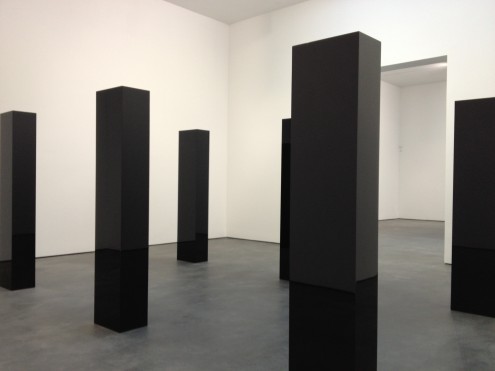
John McCracken, at Zwimmer Gallery
The idea of racial purity is pernicious wherever it arises. And this is because there is always a race better than other races. Why have the discussion otherwise. By the early 1950s, the topic was re-purposed as population control. And even today, the enviromental liberal will espouse the same theories.
“It now seems strange that men who had been conspicuous in the eugenics movement were able to move quite painlessly into the population establishment at the highest level, but if we reflect that the paymasters were the same Ford, Mellon, Du Pont, Standard Oil, Rockefeller and Shell are still the same, we can only assume that people like Kingsley Davis, Frank W. Notestein, C. C. Little, E. A. Ross, the Osborns Frederick and Fairfield, Philip M. Hauser, Alan Guttmacher and Sheldon Segal were being rewarded for past services.”
Germaine Greer
The point is, the Zionist movement, and the subsequent state of Israel were aligning themselves with many of the same people who funded the eugenicist work that Dr Rudin, Nazi colleague of Mengele, practised at the concentration camps.
David Hacohen, an early Israeli labor leader, and eventually director of the Office of Public Works and Planning, wrote in 1969, reflecting back on the early years of Israel.
“I had to fight my friends on the issue of Jewish socialism, to defend the fact that I would not accept Arabs in my trade union, the Histadrut; to defend preaching to housewives that they not buy at Arab stores; to defend the fact that we stood guard at orchards to prevent Arab workers from getting jobs there.… To pour kerosene on Arab tomatoes, to attack Jewish housewives in the markets and smash the Arab eggs they had bought; to praise to the skies the Kereen Kayemet [Jewish Fund] that sent Hankin to Beirut to buy land from absentee effendi [landlords] and to throw the fellahin [Arab peasants] off the land–to buy dozens of dunams from an Arab is permitted, but to sell, god forbid, one Jewish dunam to an Arab is prohibited; to take Rothschild, the incarnation of capitalism, as a socialist and to name him the “benefactor”–to do all that was not easy.”

Child detainees, Brownsville Texas immigration holding center. 2014
There is an interesting article by Dr. Sachlav Stoler-Liss, in Nashim, A Journal of Jewish Woman’s Studies and Gender Issues. On the topic of the early Israeli predeliction for eugenics.
“… Dr. Meir addressed the following words to parents:
Who should be allowed to raise children? Seeking the right answer to this question, eugenics is the science that tries to refine the human race and keep it from decaying. This science is still young, but it has enormous advantages. . . Is it not our duty to insure that our children will be healthy, both physically and mentally? For us, eugenics in general, and mainly the careful prevention of hereditary illnesses, has a much higher value than in other nations. Doctors, athletes, and politicians should spread the idea widely: Do not have children unless you are sure that they will be healthy, both mentally and physically.
Other doctors discovered connections between the Zionist movement, Social Darwinism, and eugenics. Dr. Binyamini explained his findings that Zionist schoolboys were taller, stronger, and tougher than their counterparts in other countries or in non-Zionist Jewish circles mainly as the outcome of a Darwinist process whereby only the strongest and healthiest Jews accepted Zionism. Non-Zionist circles were considered the decadent part of the Jewish world. Such views were quite common among Israeli doctors of that era.
In the view of the medical profession, then, the healthiest route to the formation of a strong new nation was to hold the proper Israeli mother responsible for producing only high-quality offspring.”
Dr Stoler-Liss teaches at Ben Gurion University and has written a good deal on related topics: http://bgu.academia.edu/SachlavStolerLiss
This of course was a strong current in U.S. thinking as well. And one that gained favor in both penal sciences and in the care for the mentally challenged. As recently as last year it was revealed that the California prison system sterilized women inmates without their consent. Race and class. The invention of race coincided with the Imperialist project of European powers. The fact that science lent itself so easily to the most barbaric ideologies, and practices, is only more proof that the instrumental logic of the West is predicated upon domination. Bill Gates is the latest apostle of social engineering, which is always, really, about a privileged few retaining that privilege. The class interests of all colonialists is the same.
Interesting to remember the Zionism worked very hard to stem the appeal of socialism.
“[T]here must be complete fusion [between the Jewish proletariat and] the Russian proletariat, in the interests of the struggle being waged by the entire proletariat of Russia.… [W]e must act as a single and centralized militant organization, have behind us the whole of the proletariat, without distinction of language or nationality, a proletariat whose unity is cemented by the continual joint solution of problems of theory and practice, of tactics and organization; and we must not set up organizations that would march separately, each along its own track.”
Lenin, 1918
The carnage in Gaza is the logical conclusion of all projects of dispossession. All colonial enterprises end in an ethnic cleansing, or in concentration camps.
Race. An illusion, but one useful to a system bent on control.
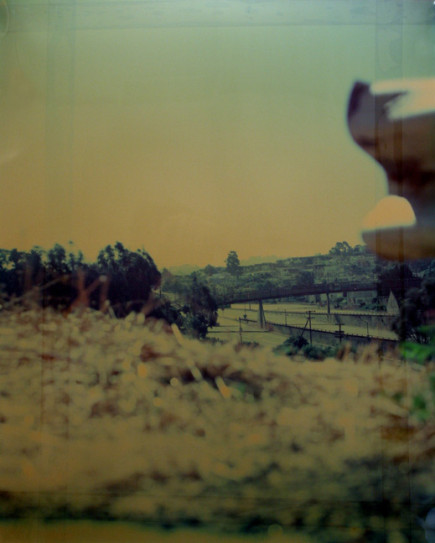
John Chiara, photography.
Here is a useful review, of sorts, on Harun Faroki. http://rhizome.org/editorial/2014/jul/25/harun-farocki/?ref=journal_p1_post_readbtn
Harun Faroki died this week at the age of 70. Here is a short overview of his work.
http://www.rouge.com.au/12/farocki.html
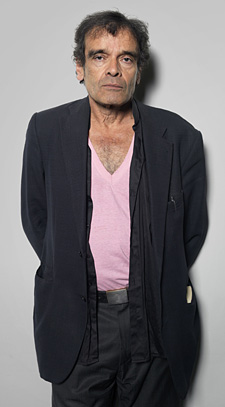
Harun Farocki, 2009
There is a new branded populism that I detect to be on the rise, at least in the U.S. It is the valorizing of kitsch by an appeal to the success (financial) of any artwork, though usually of film. And it feels as if it is the last re-entrenchment of white entitlement. It fits in seamlessly with all ideas of exceptionalism. Richard Linklater’s highly praised film Boyhood seems the new model for this white entitlement. What accounts for the nearly unanimous praise this film has received? First, I think, there is the gimmick of shooting it over a twelve year period with the same cast. This provides a fall back proof of seriousness. See, see the commitment, the patience. There is a quality of post modern sentimentality about it. White confusion. White neurosis. And the pull of the film is in this cheap emotional identification. What is actually at stake in this narrative? Very little. But it re-assures the audience about the system in which they live. It is self consciously “real”. But as Novalis once said, this is a form of romanticizing that “gives noble meaning to the vulgar, the dignity of the unknown to the known, the semblance of infinity to the finite…”. Donald Kuspit’s essay ‘Deadministering Art’ (from which I am borrowing heavily) touches on more than I think he even realized. For not only is this the state of fine arts, painting and installation art, but increasingly these terms can be applied to film. And Kuspit of course is paying homage to Adorno in this essay. And Boyhood is the definitive apologia for what is in reality a horrible system of inequality and oppression. The magnitude of exploitation and angst is reduced to what is little more than an Ozzie & Harriet family pseudo-drama.

Agnes Martin
Linklater’s meandering loopy narrative is being perceived as “subtly complex” (The Guardian), and I reminded of the same fawning adulation handed down to Malick’s Tree of Life. At least Malik registers as insane, at least often enough, to be interesting. Linklater is just tedious. Middle brow. But the more important matter is how these narratives of entitlement, of the suffering of bourgeois identity, are connected to the fabric of violence and fascist thinking. It is easy enough to point out Zero Dark Thirty, or Homeland as proto fascist police state validation, but I’d submit that Linklater is expressing another kind of equally virulent totalitarian vision. Now, totalitarian is probably not the first thing that comes to mind when discussing Richard Linklater. Linklater made Dazed and Confused when he was already almost forty. Its probably more excusable as a film if the director were 23. For it is this very preciousness, this sort of vapid confessional cuteness that is so troubling, because it masks a latent sadism. But it is the sadism of the narcissistic and puerile white man/child. It is exhibitionistic in a sense, too. Look at my problems. Look, look.
But its more than that. It is the inability to read allegory. And even, to experience the implications of metaphor. Malick puts ACTUAL dinosaurs in his film. And anytime a film begins with cosmic explosions, something is probably wrong. The implication of a cosmology probably needs to be realized by metaphor, not the literal depiction of the big bang.
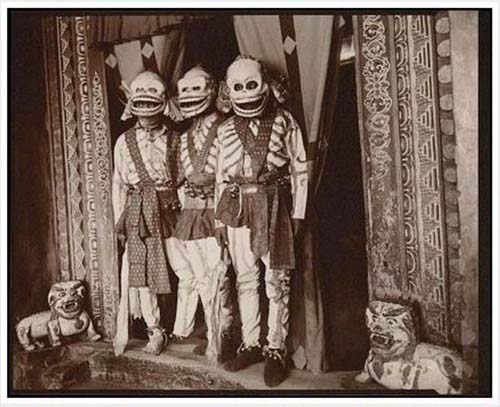
Linda Connor, photography. Death Dancers, Ladakh.
There is another problem in material like Linklater’s, and it is the fact that on a very real level the film erases history. Linklater has spoken of the effects of 9/11, though without specifying exactly what those effects were. But given the attention to the duration of the shoot, the sense of appeal to ‘history’ that this structure implies, there is actually precious little historical content. Only the most generalized banalities are allowed to encroach at all on the innate importance of this mushy subjectivity. In fact everything in the film feels generalized, and one can only conclude that the overwhelming favorable response to the film has to do with the safety and security of generalized emotion. And it is exactly at this point, in the generalized orthodox engagement with the sentimental that something can be seen of the totalitarian sensibility. For in place of depth, the viewer is given a thin veneer of place holders for feeling, for grief or suffering. In lieu of the tragic we get the boring, but it is a very particular sort of boring. One might say the films of Jean-Marie Straub and Danièle Huillet are *boring*, and in a sense, they are. But the slowness, the precision of Straub and Huillet is a strategy to dig more deeply. There are no revelations in Linklater. There is only more boredom. But this bypassing of history, in a film predicated upon its gimmick of real time aging, of time passing, becomes propagandistic by virtue of what ISNT there. In the great Charles Burnett film, Killer of Sheep, the sense of time (the film too seven years to complete, not by choice but by the challenges of finance) feels like a burden, a form of suffering that is born of a struggle for survival. The director doesnt need to say anything, we see the days and years pass without authorial comment.
In Linklater there is the basic vanilla pablum of ‘family’ presented as if it were a probing metaphysical dissection. Oh, we have our difficulties, that’s life. It is hallmark greeting card level kitsch. And it reinforces the most regressive idea of *family*. The latent misogyny is obvious. This is white people with small problems of identity, or desire, or career. It is, as a whole, an affirmation of bourgeois life, a fantasy about “childhood”, and it manufactures an ersatz version of childhood as if it were a lifestyle choice. It is the worst kind of dishonesty.

Marco Tirelli
On another note:
I did want to mention the work of Marco Tirelli. I only became aware of Tirelli a year or two ago. Tirelli is someone whose meditative pieces run counter to the noise and disposibility of much contemporary work. There are always questions that arise in Tirelli.
What is on the other side? Like Durer, he paints through, not around, in a sense. Tirelli lives in the mountains of Umbria, in a quite remote village. There is that sense of quiet in his work. Of stillness. There is no noise, no chatter. It is interesting to compare him to an Agnes Martin, or John McCraken. Now I like McCracken, at times. He has made dreadful junk, but at his best he creates glossy very effective and luminous pieces. But they are loud. McCraken is always loud. Martin is very focused, and that focus is sustained in her work. I find her work somehow less enthralling than I do certain other minimalists; say even Dan Walsh or more minor artists like Matt Connors. I dont mean minor in any negative sense. Connors is extraordinarily effective at what he does. Now a Dan Walsh is quite seductive. I dont always trust my seduction by him, but I am seduced all the same. Someone described Walsh as tantric. And actually I think that’s a good description. The rhythm of pattern is emphasized in surprising ways. The surface is inviting. Walsh is rather remarkable, actually, in that one continues to be surprised each time one returns to a specific work. In Martin I find a kind of subtle hubris, or arrogance. Martin is very clear, very concise, but she is making work that she knows will be looked at. Tirelli is doing something else, and really so is Walsh I think. They are not the same, of course.
“You knew that there were mountains and woods and a world out there yet you could not see them in the almost total blackness… and by shining a torch out into the darkness, you could see the complete division of light and darkness. The church fathers described God as light, but I began to conceive of an all-enveloping God not as light, but as darkness.”
Tirelli

Marco Tirelli
Someone once said to me, at a gallery opening, of the work on display; “Well, if it was wrapping paper, Id take that one”. Snide, but also not exactly untrue. There is a subtle a very fine line between art and wrapping paper (I guess you could say). And yet that distinction is profound in its implications I think. Part of it has to do with the entering into a relation with the whole, with reality. If an artwork is experienced merely as escape, then in a sense it is reinforcing the prevailing reality. It is not rebelling against it. I am not sure, for example, if Agnes Martin’s paintings do more than massage and offer respite. Tirelli is creating something that, at least, aspires to autonomy. And autonomy is a very illusive ideal, and rarely met, and perhaps never met. It is the impossible. But it is there when you look at Tirelli…or Luc Tuymans, Michael Borremans, Koen van den Broek, Susan Frecon, the late Raoul De Keyser, Serban Savu, R.H. Quaytman, Helmet Federle, Rudolph Stingel, Anselm Kiefer, Jannis Kounellis, and Alberto Burri. There are a dozen more. I am mentioning only, really, contemporary painters, and off the top of my head. Donald Kuspit says autonomy is more illusion than a positive reality.
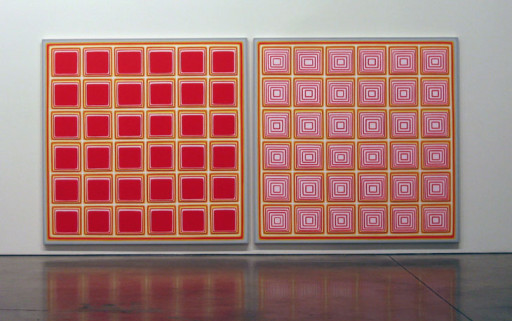
Dan Walsh
This illusion is not completely an illusion, though. The autonomy of the artwork is where the unconscious, the repressed material, resurfaces. The return of the repressed. It is that psychic space in which the “aspiration toward the infinite” (Baudelaire) is expressed, or felt. For the artist, this is the impulse to create in the first place. Each creation is partly, as Adorno says (and Kuspit quotes) “reenacting the process through which the subject comes painfully into being.”
As proof of the notion that work must now flatter the audience, there is this : http://www.newyorker.com/culture/cultural-comment/scourge-relatability
Why is Boyhood earning near unanimous praise? Because it presents a cleansed white world of neurotic concerns, solvable, in which no history intrudes. To think Linklater thought about this pap for twelve years is pretty staggering. Adorno said “without a heterogeneous moment, art cannot achieve autonomy.” There is nothing heterogeneous in Linklater. His trick is, however, to present a work that pretends to be. A Marco Tirelli is trafficking in the currency of dreams. As almost distrubingly quiet as his work is, there is something secret or at least hidden being pointed toward. It is its own small rebellion. Walter Benjamin wrote in his essay on postage stamps, that only the collectors of cancelled stamps “have penetrated the mystery, for cancellation is the occult part of the stamp, its nocturnal face.” Linklater is the uncancelled stamp. This is hugely important area for aesthetic resistance, if that’s what we choose to call it. Benjamin also wrote of the comb (which Calasso discussed) which was, each morning, the first dispelling of the residue of dreams. The Mother’s job.
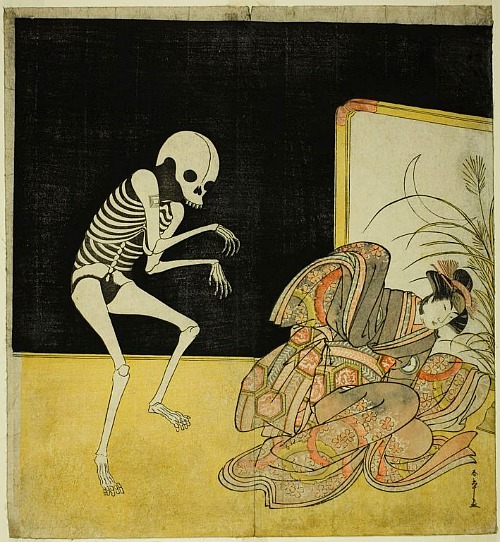
Katsukawa Shunsho, woodblock. 18th century.
The world of Richard Linklater, of most of the culture industry, is the well groomed face of Empire. Hair combed, teeth brushed (how few studio films show people with bad teeth) and a smile and firm handshake. The dreams have been removed, the night terrors scrubbed away, and hosed off those white tiles and down the drain. In which the uncancelled stamp can present its ‘scalloped edge’, and the white walls of galleries and star-architect’s projects can shine, and like the wedding dress or ocean liner, or endless reality TV show, continue to keep the lights on, the constant presentation of *now*. Benjamin wrote: “In ancient Greece, people knew of places that gave access to the Underworld. Our whole waking life is a land where at certain points we descend into the Underworld — a land full of scarcely visible places out of which dreams flow.” He added that our prehistory is found at night, groping in darkness. Today it can be the industrial city streets, or the remote wilderness. But these portals to the archaic are sites of antagonism to the status quo. They are unpoliced, secret, and illogical.

John, thanks for introducing me to Tirelli. First time I’ve encountered his work and it’s very interesting. His quote about God being darkness is something I’ve been contemplating lately with writing film – which is at once greatly overvalued and under appreciated. The current script I’ve been working on is an attempt to write a film about femicide without showing a single murder. The way I’ve been attacking it is to depict the geography of a city, in this case L.A., as a series of murder scenes, and the characters as both perpetrators and detectives returning to the scene of the crime. Anyway, a lot of this involves concealing details, which leads me to explore darkness, not being able to see what is there, although it’s there… There’s a certain sanctity about it, a kind of faith, because God is there overlooking it all. In fact, God might be trying to piece it all together too.
Another comment that resonates with me is the one about wrapping paper. I think people do this with most consumerist product, but mainly with film. They wrap the film around their lives like a a flag of sorts. This identification with the film prevents any kind of real critical thought. Boyhood is the most immediate case we’ve seen. White hipster patriarchy, slacker sensibility.
I know we’ve disagreed about Mallick’s Tree of Life, a film which hasn’t held up for me in the last year. Mallick’s film feels like bad poetry to me. What is bad poetry, other than lack of rhythm? It’s the inability to use metaphor, right? Mallick has no sense of metaphor. He films what he wants to convey directly. His film is closer to a Top 40 pop song than a symphony. I still find interesting elements in his films. His last one TO THE WONDER felt like he was taking Hemingway’s advice on writing (Take all the good lines out and see if it’s still good). Well, Mallick removed all the lines of dialogue from that film and filmed the moments before, in-between, and after. Unfortunately, the film wasn’t any good, although it was a noble failure.
I have some thoughts on relatability on one hand and the culture of cruelty in the neoliberal west on the other hand: I think they’re definitely directly related. Cosymptoms actually. Since the culture industry directly erases any trace of history in their work, so tbe imagination of my generation does not extend one iota beyond the immediate present, “relateability” becomes a highly specific phenomena, which is actually the opposite of identification: since what is relateable is empirical, limited to our specific milieu, and by definition excluding of tragedy,
haracters outside of our familiar conditions of life are depicted, or a social environ even slightly differing from our class and identoty, nevermind the unempirical fantastic absurd or fallegorical, we become utterly stumped and unable to IDENTIFY, unable to PROJECT, so that the character’s lives don’t seem human. We don’t think people who flive elsewhere, in other eras, under other class positions, actually have impulses and yearnings and emotions we can identify
and we certainly reject tragedy, which is the recognition that suffering is the only truth of life, our culture of cruelty becomes almost inevitable: we don’t think “other people” actually have lives, we dont identify with “foreigners”, and we certainly dont believe it when we notice people suffering. And those in turn are the psychic condition of those who make art, so that the cycle feeds on itself like a snake on its tail.
@joe: Malick having no sense of metaphor is exactly right. But i think audiences today have a hard time even reading metaphor, actually.
@Exir…..thats a good description of relatability: I do think its not quite the opposite of identification though. Although perhaps it is. But it depends on how you define identification I guess. But the constant marvell comic franchises, and the Hobbit junk, and even Hunger Games, is very simple one dimensional allegory. If it even rises to that definition. It creates this imaginary landscape that is only a sort of distillation of certain features of our own sort of criminalized landscape of fear. They are paranoid narratives of threat. And the solutions are always state violence of some sort, alligned with vigilantism. The relatable part has to do with this anti elitist trend, this weird new populism. And it is a populism that denies any historical critique as itself elitist. The desire is to have *entertainment* validated. If you dont like entertainment, you are a snob. I cant count the number of times Ive been attacked as a snob. There seems to be, increasingly, a rejection of any idea of taste….and i want to post about taste next time i think. But exir, your comment about other people not having lives is quite right. So as you suggest, there is a closing in of discourse. It is contained within an ever narrow frame. Everything can be described as an episode of Breaking Bad. Politics is seen as Hunger Games. And there are not that many artists now creating work that steps outside this. And there is, for example, a growing dislike of Shakespeare for example. And partly this is because of how its taught. Its not easy to discuss shakespeare in our current cultural moment. For what shakespeare is doing has nothing to do with Hunger Games or Avatar or Boyhood. And i wanted to add that Boyhood’s gimmick, this shooting over 12 years is an example of the literalism, that lack of metaphorical comprehension, for it is suggesting this documentary verisimilitude, that means oh, this is so realistic….without ever questioning the assumed meaning of real. If you just show actual aging, somehow this enhances the narrative’s realism, its value. It is removing that which is outside, it diminishes imagination and metaphor.